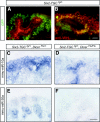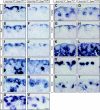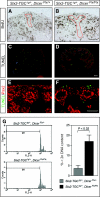The pro-apoptotic protein Bim is a microRNA target in kidney progenitors
- PMID: 21546576
- PMCID: PMC3103725
- DOI: 10.1681/ASN.2010080841
The pro-apoptotic protein Bim is a microRNA target in kidney progenitors
Abstract
Understanding the mechanisms that regulate nephron progenitors during kidney development should aid development of therapies for renal failure. MicroRNAs, which modulate gene expression through post-transcriptional repression of specific target mRNAs, contribute to the differentiation of stem cells, but their role in nephrogenesis is incompletely understood. Here, we found that the loss of miRNAs in nephron progenitors results in a premature depletion of this population during kidney development. Increased apoptosis and expression of the pro-apoptotic protein Bim accompanied this depletion. Profiling of miRNA expression during nephrogenesis identified several highly expressed miRNAs (miR-10a, miR-106b, miR-17-5p) in nephron progenitors that are either known or predicted to target Bim. We propose that modulation of apoptosis by miRNAs may determine congenital nephron endowment. Furthermore, our data implicate the pro-apoptotic protein Bim as a miRNA target in nephron progenitors.
Figures






Similar articles
-
Bim gene dosage is critical in modulating nephron progenitor survival in the absence of microRNAs during kidney development.FASEB J. 2017 Aug;31(8):3540-3554. doi: 10.1096/fj.201700010R. Epub 2017 Apr 26. FASEB J. 2017. PMID: 28446592 Free PMC article.
-
Bim and Mcl-1 exert key roles in regulating JAK2V617F cell survival.BMC Cancer. 2011 Jan 19;11:24. doi: 10.1186/1471-2407-11-24. BMC Cancer. 2011. PMID: 21247487 Free PMC article.
-
Dicer function is required in the metanephric mesenchyme for early kidney development.Am J Physiol Renal Physiol. 2014 Apr 1;306(7):F764-72. doi: 10.1152/ajprenal.00426.2013. Epub 2014 Feb 5. Am J Physiol Renal Physiol. 2014. PMID: 24500693 Free PMC article.
-
Bim and the pro-survival Bcl-2 proteins: opposites attract, ERK repels.Cell Cycle. 2007 Sep 15;6(18):2236-40. doi: 10.4161/cc.6.18.4728. Epub 2007 Jul 10. Cell Cycle. 2007. PMID: 17881896 Review.
-
Bim: guardian of tissue homeostasis and critical regulator of the immune system, tumorigenesis and bone biology.Arch Immunol Ther Exp (Warsz). 2011 Aug;59(4):277-87. doi: 10.1007/s00005-011-0126-1. Epub 2011 Jun 3. Arch Immunol Ther Exp (Warsz). 2011. PMID: 21633919 Review.
Cited by
-
MicroRNAs and fibrosis.Curr Opin Nephrol Hypertens. 2012 Jul;21(4):410-6. doi: 10.1097/MNH.0b013e328354e559. Curr Opin Nephrol Hypertens. 2012. PMID: 22622653 Free PMC article. Review.
-
microRNA control of mouse and human pluripotent stem cell behavior.Annu Rev Cell Dev Biol. 2013;29:213-239. doi: 10.1146/annurev-cellbio-101512-122343. Epub 2013 Jul 12. Annu Rev Cell Dev Biol. 2013. PMID: 23875649 Free PMC article. Review.
-
Complex Pathophysiology of Acute Kidney Injury (AKI) in Aging: Epigenetic Regulation, Matrix Remodeling, and the Healing Effects of H2S.Biomolecules. 2024 Sep 17;14(9):1165. doi: 10.3390/biom14091165. Biomolecules. 2024. PMID: 39334931 Free PMC article. Review.
-
Gestational Low Protein Diet Modulation on miRNA Transcriptome and Its Target During Fetal and Breastfeeding Nephrogenesis.Front Physiol. 2021 Jun 22;12:648056. doi: 10.3389/fphys.2021.648056. eCollection 2021. Front Physiol. 2021. PMID: 34239447 Free PMC article.
-
Towards microRNA-based therapeutics for diabetic nephropathy.Diabetologia. 2013 Mar;56(3):444-56. doi: 10.1007/s00125-012-2768-x. Epub 2012 Nov 8. Diabetologia. 2013. PMID: 23135222
References
-
- Dressler GR: The cellular basis of kidney development. Annu Rev Cell Dev Biol 22: 509–529, 2006 - PubMed
-
- Schedl A: Renal abnormalities and their developmental origin. Nat Rev Genet 8: 791–802, 2007 - PubMed
-
- Bernstein E, Kim SY, Carmell MA, Murchison EP, Alcorn H, Li MZ, Mills AA, Elledge SJ, Anderson KV, Hannon GJ: Dicer is essential for mouse development. Nat Genet 35: 215–217, 2003 - PubMed
Publication types
MeSH terms
Substances
Grants and funding
LinkOut - more resources
Full Text Sources
Medical

